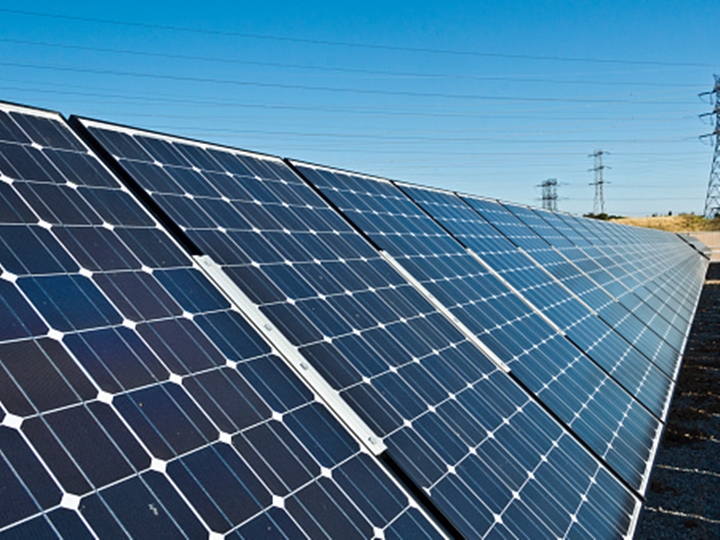One Sun, One World, One Grid.
~Preet

This image does not belong to the writer or the publisher. It was taken from https://news.abplive.com/news/world/india-and-uk-to-launch-solar-grid-project-green-grids-initiative-at-cop26-report-1491040
At the Conference of Parties (COP26) in Glasgow, UK, India and the United Kingdom jointly proclaimed "one sun, one world, one grid" — or OSOWOG. GGI-OSOWOG was founded in 2018 to create worldwide linked solar energy systems. In collaboration with the United Kingdom, India announced the start of the Green Grids Initiative — One Sun, One World, One Grid (GGI-OSOWOG) under the International Solar Alliance. The OSOWOG's objective is 'The Sun Never Sets,' and it is constantly in some geographical spot, globally, at any given moment. The initiative aims to provide a framework for global collaboration on the effective use of renewable resources and to guarantee that clean and efficient energy is a reliable alternative for all nations to satisfy their energy needs by 2030. This project aims to capture the sun's light and construct a global linked electrical grid to hasten the transition to renewable energy. The effort is anticipated to connect over 80 countries spread across a broad geographical area with varied quantities of sunshine. A transitional system will allow countries with little daylight to acquire energy from regions with an abundance of it.
The connectivity of Indian grids with the grids of the Middle East, South Asia, and Southeast Asia (MESASEA). Interconnection of MESASEA networks with the African power grid. Finally, there is global interconnection. It will increase technical, financial, and scientific collaboration to facilitate cross-border renewable energy transfer initiatives, providing OSOWOG with global infrastructure. It will also create a depth of organisational scale, spanning national governments, international financial and technical organisations, legislators, power system operators, and knowledge leaders, to accelerate the construction of the new infrastructure required for a clean energy-powered world. It will allow a quicker transition to a global ecosystem of linked renewables shared for mutual benefit and global sustainability. It will generate momentum and a pool of investment for low-carbon, creative solar projects and bring talented employees together for a solar-powered economic resurgence. It has the potential to spur investment and create millions of new green employees. It will result in lower project costs, better efficiency, and increased asset utilisation for all parties involved. It will provide economic advantages, aid in poverty alleviation, and assist in mitigating water, sanitation, food, and other socioeconomic difficulties. Allow India's national renewable energy management centres to expand into regional and global management centres.
The GGI documentation does not mention enhancing the efficiency of the country's current solar energy infrastructure. Most solar energy infrastructure is located in arid areas, where dust accumulates on panels. A coating of dust reduces the efficiency of solar power conversion by 40%. Solar energy technology, such as batteries and panels, relies on energy-intensive raw materials, chemicals, and heavy metals that must be handled and disposed of properly. It does not identify techniques for recycling and repurposing existing infrastructure, which might be a fascinating subject to explore from the circular economy perspective. Solar panels typically have a lifespan of 25 years before they must be discarded due to inefficiency. Due to heatwaves (when demand increases) and coal shortages, India, as a thermal energy-dependent country, confronts significant electricity shortages in many locations. GGI has the potential to change the existing energy system by replacing thermal power plants with solar energy, making India more robust to adverse weather and less reliant on fossil fuels. Solar energy has improved the lives of millions of people in rural India, allowing them to carry out activities and raise their living levels while being ecologically benign. One example is using solar-powered farm pumps (PM-KUSUM) to extract groundwater, which is less harmful to the environment than standard diesel pumps. In India, there are 10 million diesel pumps. It is anticipated that replacing 1 million diesel pumps with solar-powered pumps may increase agricultural output by Rs 30,000 crore while simultaneously reducing fuel use. The application of GGI can improve the quality of life in many other areas, such as access to technological devices and safe drinking water.
Solar power's environmental costs, efficiency concerns, energy losses due to conversion and transport, and waste management issues are all obstacles that must be addressed promptly by implementing organisations. Due to waste disposal concerns, deploying GGI in India has a higher environmental cost. These challenges must be overcome by building particular mechanisms for reusing and recycling existing infrastructure. The costs and benefits must be carefully considered for the programme to succeed in India. Its adjustments must be prepared per the country's needs and resource capabilities. Building institutions is critical to achieving the goals of a multi-country grid project. In this scenario, the International Solar Alliance (ISA) can operate as an independent international entity to decide how the grid should be administered and resolve problems.
Comments
Post a Comment